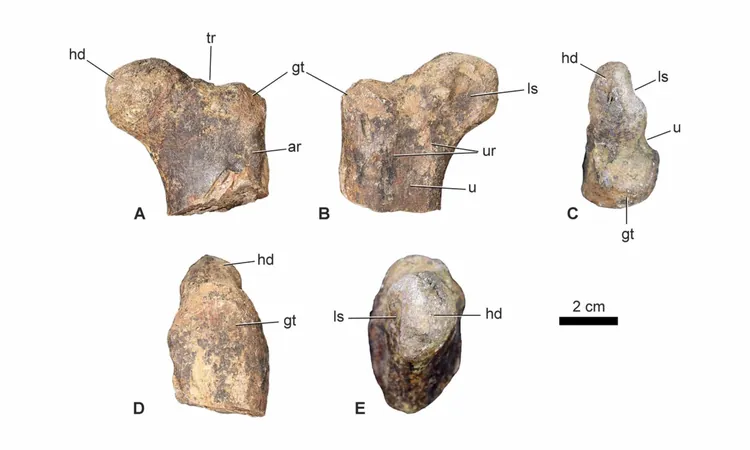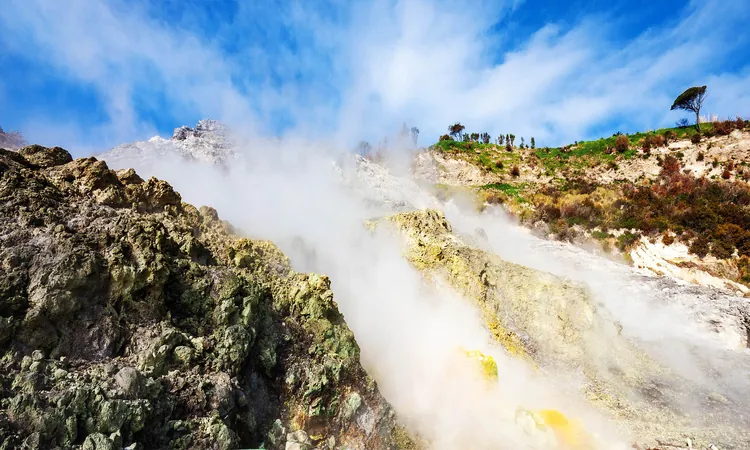
Ancient Dinosaur's Bone Found: The 165-Million-Year-Old Revelation that Could Change Everything!
2025-05-16
Author: Ken Lee
Unearthing a Jurassic Gem
A newly discovered fossilized femur belonging to a cerapodan dinosaur is shaking up the science world, pushing the boundaries of our understanding of dinosaur evolution back by 165 million years. This groundbreaking find not only rewrites history but also shines a light on a lesser-known group of dinosaurs.
Meet the Cerapoda: The Unsung Heroes of Dinosaur History
While names like Tyrannosaurus and Velociraptor are household words, the Cerapoda remain in the shadows. This group of plant-eating giants includes everything from the duck-billed hadrosaurs to the iconic horned ceratopsians. Thanks to this new discovery in Morocco, the narrative surrounding the cerapodans is set to change dramatically.
A Major Evolutionary Breakthrough
This remarkable femur, believed to be the oldest evidence of a cerapodan, provides an unprecedented glimpse into their early existence. Team member Dr. Susannah Maidment from the Natural History Museum in London emphasizes its significance: "Cerapoda is a diverse clade of ornithischian dinosaurs with a global distribution." This fossil enhances our understanding of their evolution.
Connecting the Dots of Time
Previously, cerapodan history primarily stretched across the Late Jurassic and onward, but this discovery pushes their timeline back significantly. Researchers have discovered unique traits in the femur that align with characteristics specific to cerapodans, indicating these dinosaurs diversified much earlier than previously thought.
Why This Discovery Matters
Footprints in the Middle Jurassic already hinted at cerapodans' presence, but solid fossils have remained elusive. This latest find validates those footprints and may close critical gaps regarding early adaptations in stance, movement, and feeding strategies that contributed to the cerapodans' later success. It sets the stage for revealing how they evolved from smaller, bipedal relatives into the colossal herbivores that we recognize today.
Unlocking the Mysteries of the Middle Jurassic
To confirm the femur's astounding age, scientists meticulously examined the geological layers surrounding the discovery site. By comparing it to other known fossil-bearing rocks globally, they solidified the significance of this find.
A Gateway to Future Discoveries
Excitement is building within the paleontological community for more finds like this one. As researchers continue to explore Morocco's unexplored stratums, they remain hopeful that new discoveries may bring an even clearer understanding of cerapodans and their spectacular adaptations.
Broader Implications for Jurassic Ecosystems
This ancient femur not only sheds light on the cerapodans' evolution but also offers a glimpse into the ecosystems of 165 million years ago, hinting at diverse ecological niches available to specialized plant-eaters well before the Cretaceous period. The Middle Jurassic serves as a backdrop for dinosaur adaptation and diversification, and every uncovering connects the dots in a complicated evolutionary puzzle.
The Future of Cerapodans and Dinosaur Research
The implications of this single bone extend beyond mere classification. It challenges existing assumptions about the tempo of dinosaur evolution and underscores the complexity of their adaptation, feeding habits, and bodily structure over time.
Dive Deeper into the Past!
The ongoing study of these fascinating bones will undoubtedly unveil more about how cerapodans transitioned from their bipedal origins to the larger, more specialized forms we see in the fossil record today. As paleontologists continue to unravel the mysteries of the Jurassic age, each discovery paves the way for a deeper understanding of our planet's prehistoric giants.



 Brasil (PT)
Brasil (PT)
 Canada (EN)
Canada (EN)
 Chile (ES)
Chile (ES)
 Česko (CS)
Česko (CS)
 대한민국 (KO)
대한민국 (KO)
 España (ES)
España (ES)
 France (FR)
France (FR)
 Hong Kong (EN)
Hong Kong (EN)
 Italia (IT)
Italia (IT)
 日本 (JA)
日本 (JA)
 Magyarország (HU)
Magyarország (HU)
 Norge (NO)
Norge (NO)
 Polska (PL)
Polska (PL)
 Schweiz (DE)
Schweiz (DE)
 Singapore (EN)
Singapore (EN)
 Sverige (SV)
Sverige (SV)
 Suomi (FI)
Suomi (FI)
 Türkiye (TR)
Türkiye (TR)
 الإمارات العربية المتحدة (AR)
الإمارات العربية المتحدة (AR)